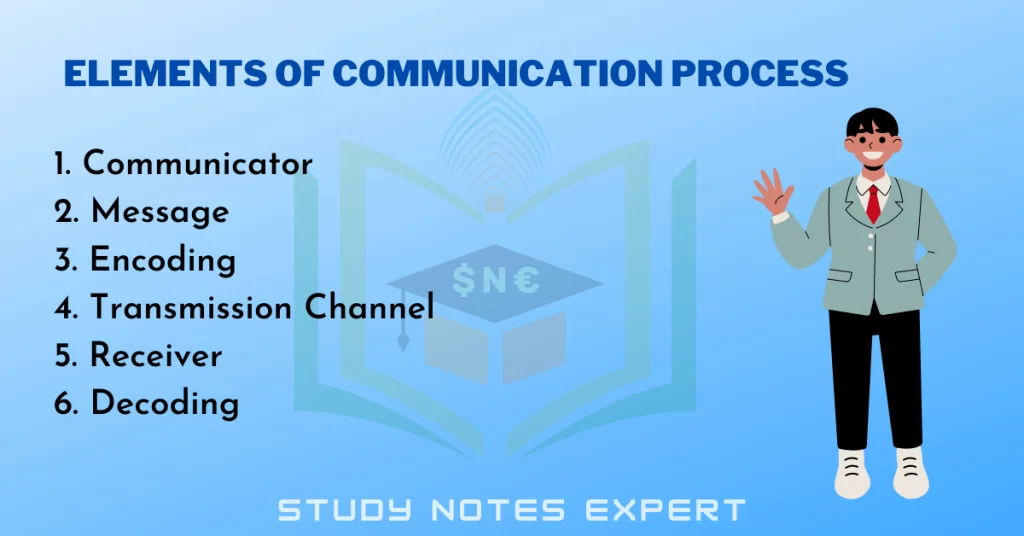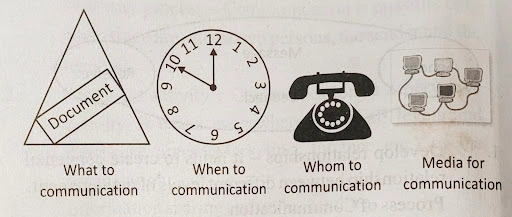“Scot Ober” rightly points out that Communication is the process of sending and receiving messages, sometimes through spoken or written words and sometimes through non-verbal means such as facial expressions, gestures & voice qualities. It is a complete communication cycle that is completed while transferring ideas or messages. In this article, you will know the different elements of communication process.
Elements of Communication Process

The process of transmission & Communication all only complete if the receiver’s understanding is known through his response. That’s why communication is regarded as a two-way process. One must keep this in view for the success of any communication process.

1. Communicator
The person who conveys the message is known as the communicator or sender. The sender can be any individual, group or an organization as elements of communication process.
2. Message
The message is the encoded idea transmitted by the sender. A sender has to express her purpose in the form of a message.
3. Encoding
Encoding is the process by which the sender converts the idea into a message using verbal or non-verbal mediums. These can be words, signs, gestures, symbols or body movements. It is one of the elements of communication process. There are three encoding skills-
- Speaking
- Writing
- Body language
4. Transmission Channel
Channel is the vehicle that carries the message to the receiver. It works as the elements of communication process. For Communication to be effective & efficient, the channel must be appropriate for the message. The various channel include:-
- Postman
- Computer
- Fax
- Letter
- Telephone
- Picture
- Radio Television
- Memorandum etc.
The channel choice depends on the purpose of Communication, the sender’s needs & profile of the receiver, and other different elements of communication process.
5. Receiver
The receiver is any individual to whom the message has been transmitted. The element of perception plays a significant role in the acceptance or rejection of the message. The communication’s success or failure also depends on how the receiver receives the message. It is rightly said it is the important elements of communication process as well as communication is the message perceived & not the message sent.
6. Decoding
Decoding is the process by which the receiver interprets the message to transform it into meaningful information. It is one of the important elements of communication process.
Decoding involves two things:

- One is technically receiving the message as it has been sent, and the other interprets the message the way the sender wants to understand.
- Decoding is affected by the receiver’s experience, expectations, and personal assessment of the symbols & gestures used.
1. Feedback
Feedback is the recipient’s reaction to the communication sent by the sender. It is also an important elements of communication process. Both verbal and nonverbal responses are acceptable. Because it enables the sender to determine whether or not the message has been understood, it is crucial to communication.
2. Noise
Noise is any disturbance that occurs, reduces or confuses the message’s clarity or quality. Work can be from various sources:-
a) Physical Noise
The external factors that distract Communication fall under this category. It includes noise from vehicles, noise from television and disturbance in phoneline.
b) Physiological noise
They are learning disorders due to illness and disabilities that make sending and receiving messages difficult. Psychological Noise consists of the forces within the sender or receiver that interfere with understanding. It is the important elements of communication process.
What are the Elements of the Communication Process?
The communication process comprises numerous important swot analysis components that function in concert to transmit a message from a sender to a receiver. These components include the sender, message, channel, receiver, and feedback. The following three pieces of knowledge are crucial to understanding the elements of communication:
1. The communication process includes the sender, message, channel, receiver, and feedback.
2. The person or thing that starts the communication is known as the sender.
3. The person or thing that receives and understands the communication is the receiver.
What is the Message in the Communication Process?
The message in the communication process is the information, concept, or emotion the sender wants to convey to the recipient. The sender must utilise clear, succinct language and the proper tone to ensure the message is effectively transmitted. In the communication process, the following three pieces of information are crucial:
1. The message in the communication process is the information, concept, or emotion the sender wants to convey to the recipient.
2. The message must be clear and brief to ensure accurate transmission, and the sender must utilize the right language and tone.
3. To achieve effective communication, the message must also be adjusted for the comprehension capacity of the audience.
What is the Channel in the Communication Process?
The medium used to transmit a message from the sender to the recipient is the channel in the conversation manner. The track may be vocal or nonverbal, involving face-to-face, written, digital, and other conversations. The following three pieces of records are crucial to the conversation procedure:
1. The channel inside the communication system is the medium used to transmit a message from the sender to the recipient.
2. The channel may be vocal or nonverbal, regarding face-to-face, written, digital, and different conversations.
3. The sender must pick the high-quality channel based totally on the message and the recipient because the channel choice may affect communication effectiveness.
What is Feedback in the Communication Process?
Feedback in the context of communication refers to the recipient’s response or emotional response to the message. Feedback can be verbal and nonverbal, giving the sender crucial knowledge about the success of the message. The following three pieces of input in the communication process are essential:
1. Feedback in the context of communication refers to the recipient’s response or emotional response to the message.
2. Feedback can be verbal and nonverbal, giving the sender crucial knowledge about the success of the message.
3. To guarantee effective communication, the sender must consider the feedback and modify the message and communication strategy.

